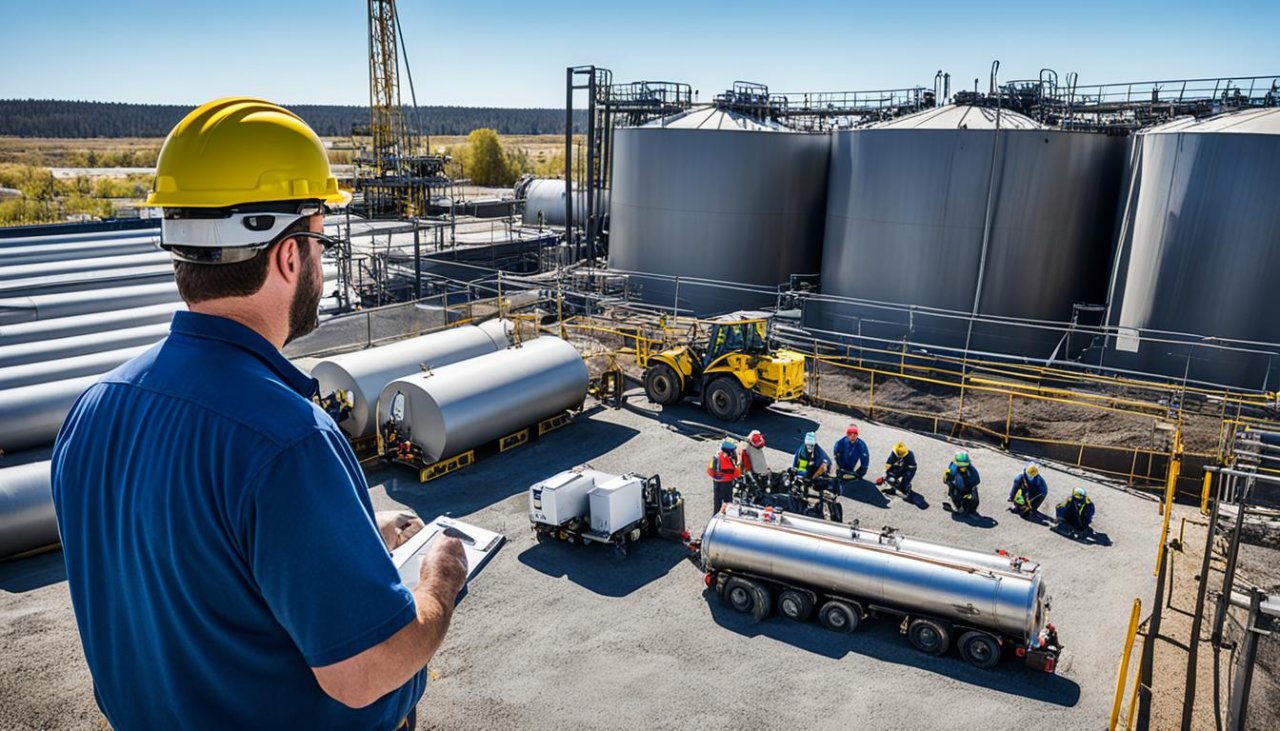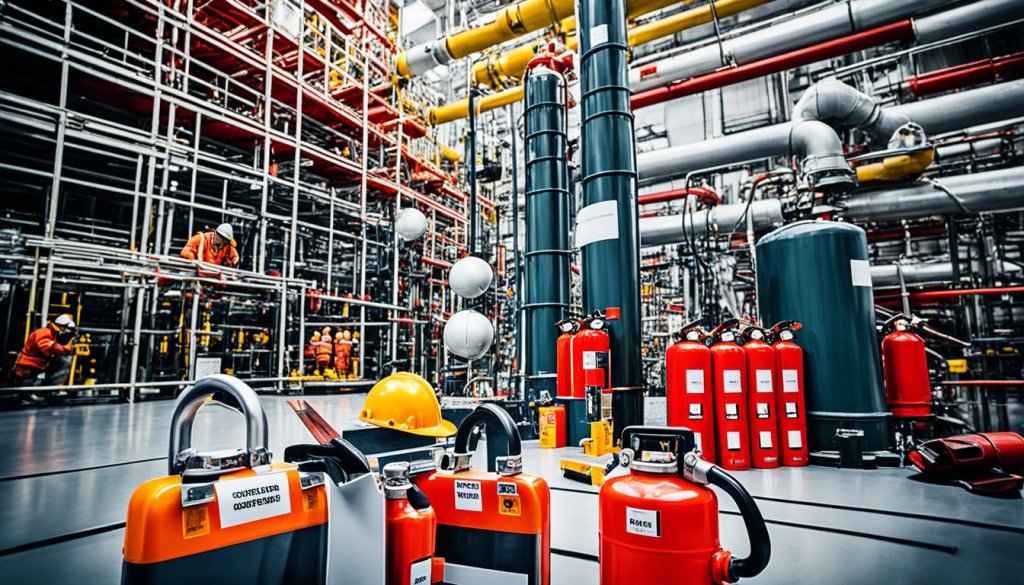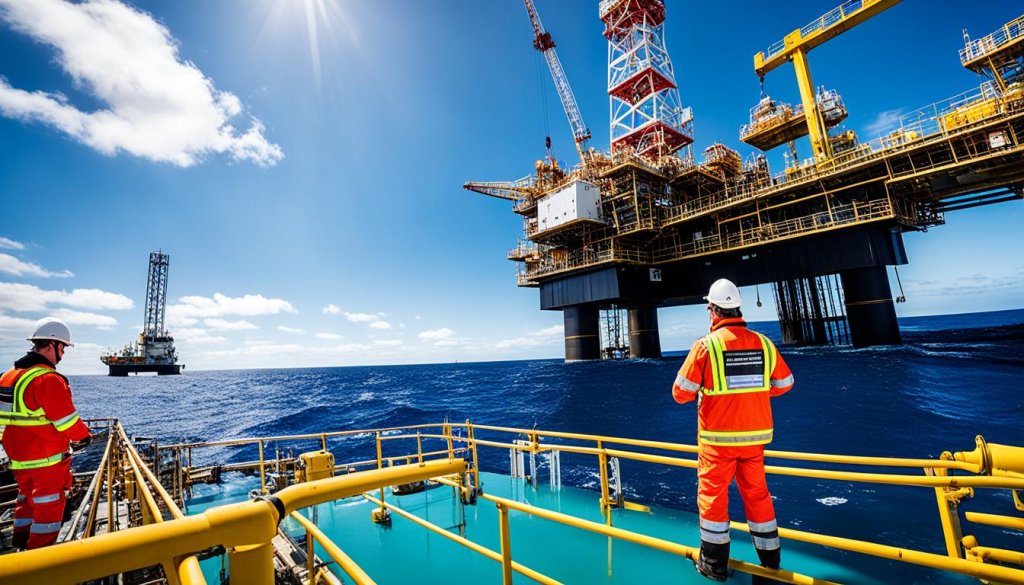Every day, workers in the oil and gas industry face tough challenges. They work hard to give us the energy we need. I recall a moment on a drilling site where a supervisor stopped the drill just before it started. This was because a key piece of equipment didn’t follow safety rules.
This close call could have prevented serious harm. It showed me how vital safety standards are in the oil and gas world. Since 1970, groups like OSHA have pushed for better safety. Leaders in the industry must focus on making safety a top priority.
Creating a safety-first culture helps protect workers and keeps operations running smoothly. By doing this, we make sure our industry is safe and efficient.

Key Takeaways
- The importance of comprehensive safety programs for oil and gas workers.
- OSHA has been leading safety standard enforcement since 1970.
- Regular training can significantly reduce workplace incidents.
- PPE adherence is crucial, with 25% of injuries linked to improper use.
- Emergency response planning minimizes the impact of hazardous events.
- Effective hazard communication improves workplace safety.
- Utilizing software like FAT FINGER enhances operational safety measures.
The Importance of Safety in the Oil and Gas Sector
Ensuring safety in the oil and gas sector is crucial because of the dangers workers face. In 2020, there were 578 pipeline incidents that led to explosions, fires, and loss of life. Almost 70% of these fatal events were caused by safety issues like bypassing controls, working in confined spaces, and doing hot work.
Every life is precious, and that’s why I focus on protecting employees. From 2013 to 2017, about 489 oil and gas workers lost their lives. This shows how dangerous safety lapses can be. The Piper Alpha explosion is a reminder of the need for constant safety improvements.
Having good safety measures helps keep the public healthy by reducing the risk of toxic releases and accidents. Following safety rules is key to creating a safe work culture. Leaders in the industry must put safety first as a legal and moral duty. This way, the oil and gas sector can protect its workers and keep our environment safe for the future.
Understanding the Risks Faced by Oil and Gas Workers
Working in the oil and gas sector comes with many risks. I must be alert to these dangers every day. Workplace hazards can affect both safety and productivity. In oil field services, I often face chemical exposure and injuries from machinery.
These risks can lead to serious health issues or accidents. Offshore drilling adds more challenges. Workers deal with high-pressure situations and the risk of environmental spills.
It’s important to understand these dangers to create effective safety measures. Awareness is key, but it’s not enough. Employers must educate employees about hazards and provide resources to reduce them.
Keeping the oil and gas industry safe requires teamwork. It’s crucial to focus on training and enforcing strict safety rules.
Implementing a Comprehensive Safety Program
A comprehensive safety program is key for keeping employees safe in the oil and gas services sector. It focuses on effective safety strategies to lower risks and build a safety-first culture. Important parts make up a good safety program.
Components of an Effective Safety Program
Regular safety meetings are crucial for a strong safety program. They cover important topics like how to use personal protective equipment (PPE), spotting hazards, and what to do in emergencies. Getting employees involved makes them feel responsible and encourages them to keep the workplace safe.
Regular Training and Maintenance Checks
Training and maintenance checks are vital for making sure safety steps are followed correctly. I believe in ongoing training through workshops and giving access to the latest safety information. Regular checks on machines and tools prevent breakdowns, which helps avoid accidents in the oil and gas sector. Practical training helps workers learn safety skills, preparing them for any dangers they might face.

Using Personal Protective Equipment (PPE) in Oil and Gas Businesses
In the oil and gas industry, using Personal Protective Equipment (PPE) is crucial for keeping workers safe. Important safety gear includes hard hats, safety glasses, gloves, respirators, and steel-toe boots. Each piece is made to protect against different dangers at work.
Employers must follow OSHA rules, like OSHA 1910.132, to pick the right PPE. They need to assess the hazards and match the gear to the job’s needs. Workers must get their PPE for free, as the law says. Talking with coworkers and experts helps find the best PPE for the job.
The quality of PPE, like masks or gloves, depends on the materials used. For example, neoprene or nitrile gloves are options. Training workers on how to use their PPE correctly lowers the chance of getting hurt. With dangers like flash fires reaching over 1900 degrees Fahrenheit, having the right safety gear is essential.
Dealing with COVID-19 has shown the importance of updating PPE use. Comfort, durability, and being able to reuse PPE affect how well workers follow safety rules. New technology, like treating fabrics for flame resistance, helps make work safer. With the right PPE, the oil and gas industry can keep its workers safer than ever.
Establishing Emergency Response Protocols
Creating effective emergency response protocols is key for safety in oil and gas companies. This industry is unpredictable, so focusing on crisis management is crucial. It’s important to have clear emergency plans ready for different hazards like fires, spills, and natural disasters.
Each emergency plan should be made to fit the specific challenges of each site. This ensures a proactive way to handle emergencies.
Creating Clear Emergency Plans
Starting with identifying potential hazards at the worksite is the first step in making a good emergency response plan. Companies should focus on risks like chemical spills, explosions, and environmental threats. Having clear communication protocols is crucial in emergencies to share important info and instructions with the team.
Regular drills and reviews of these plans make the team more familiar and confident. This makes the company better prepared for serious incidents.
Training Employees for Emergency Situations
Training employees is key for a good emergency response. The oil and gas sector has a high risk of accidents, so workers need to be ready. Regular training and drills help employees know what to do in emergencies, reducing injuries and environmental damage.
An effective emergency plan depends on quick detection and action during incidents. Feedback from drills helps improve the protocols over time, creating a culture of continuous learning.
Implementing a Risk Management Plan
A risk management plan is crucial for the oil and gas industry. It helps tackle the many challenges they face. Knowing how to spot hazards is key to lowering risks in operations. This way, companies can keep their workers and the environment safe.
Identifying Potential Hazards
Spotting hazards means doing detailed checks to find risks in different tasks and equipment. The oil and gas sector faces many dangers, like unstable prices and harm to the environment. By doing thorough risk assessments and getting everyone involved, companies can build a safety-first culture. This helps keep workers safe and makes operations more efficient.
Conducting Safety Drills for Preparedness
Having regular safety drills is key to making sure employees can deal with emergencies. These drills help workers practice what to do in an emergency, making them better at reacting in real situations. By focusing on being ready through drills, companies show they take risk management seriously. This also makes their operations safer overall.

Supporting Workers with Compensation and Insurance
In the oil and gas industry, having a strong worker’s compensation policy is key. It helps employees who get hurt on the job. They get the medical care and money they need while they recover.
It’s important for employers to keep good records of work-related incidents. This helps with following the law and making work safer in the future.
Telling employees about their worker’s compensation rights builds trust. It shows they’re a top priority. This boosts morale in the workplace.
Companies in the oil and gas sector can do better by managing claims well and helping workers early. This helps workers get better faster and keeps costs down.
The oil and gas industry is changing, with more young workers joining. Offering insurance that meets their needs is key to keeping them. A good worker’s compensation plan supports employees and makes the industry stronger.
The Role of Regulatory Compliance in Safety
In the oil and gas industry, following the law is key to keeping everyone safe. Government agencies set strict rules for things like keeping equipment in good shape and training workers. It’s important to know these rules to stay compliant and build a safe work culture.
Key Regulations Impacting the Oil and Gas Industry
Groups like OSHA make rules for keeping workplaces safe in the oil and gas sector. These rules change often to match new risks and safety tech. It’s crucial to train workers well to prevent injuries and protect everyone’s interests.
Keeping track of incidents and reporting them is also key. Without good safety measures, the chance of accidents goes up a lot.
Consequences of Non-Compliance
If companies don’t follow safety rules, they can face big fines and legal trouble. This can hurt their reputation. The EPA checks on environmental rules too, making sure companies follow them.
Companies that don’t follow the rules might have to stop working or lose customers. Putting effort into understanding and following safety rules helps reduce risks and keeps the workplace safe.
Conclusion
Improving safety in the oil and gas industry is crucial for protecting workers and keeping operations running smoothly. A strong safety program with training, protective gear, and following rules can greatly reduce risks. When leaders focus on safety, they build a culture that lowers risks and cares for employees.
Looking at the challenges oil and gas workers face, it’s clear that knowing the risks helps leaders make better plans. Big oil companies, national ones, and new low-carbon projects are all working together. This makes making the oil and gas sector safer easier than before. Their ongoing efforts not only make things safer but also help the industry last longer.
The oil and gas industry must see that making safety better is more than just following rules. It’s about building a strong foundation for growth and keeping things running right. By putting effort and money into safety, we can meet the changing energy needs. And we’ll keep our workers safe and sound.
See how FieldAx can transform your Field Operations.
Try it today! Book Demo
You are one click away from your customized FieldAx Demo!
FAQ
Why is safety so important in the oil and gas industry?
Safety is key in the oil and gas industry because workers face dangerous conditions. It keeps employees safe, prevents environmental harm, and avoids big financial losses.
What are common risks encountered by oil and gas workers?
Workers in the oil and gas industry face risks like exposure to harmful substances and dangerous gear. They also deal with tough conditions like extreme weather. Offshore drilling adds its own set of dangers, including high-pressure situations and the risk of spills.
What should be included in a comprehensive safety program?
A good safety program must offer regular training for employees, detailed checks on equipment, clear safety rules, and a safety committee. This committee makes sure the safety steps are followed and gets better over time.
How does Personal Protective Equipment (PPE) help in enhancing workplace safety?
PPE is vital for protecting workers from physical and chemical dangers. It includes things like hard hats, safety glasses, gloves, respirators, and steel-toe boots. These items lower the chance of getting hurt at work.
What are effective strategies for emergency response in the oil and gas sector?
Good emergency plans, regular drills, and training all employees on their roles in emergencies are key. Being prepared like this cuts down on injuries and deaths in crisis situations.
What steps should be taken for proper risk management in oil and gas operations?
Companies should do detailed risk assessments to spot dangers, set up safety drills, and train staff to know hazards and act right in emergencies. This way, safety gets better overall.
How does workers’ compensation support oil and gas employees?
Workers’ compensation gives injured employees money and medical help. It’s crucial for keeping trust and showing that the company cares about its workers’ health.
What regulations must oil and gas companies comply with to ensure safety?
Companies in the oil and gas industry must follow safety rules from agencies like OSHA and the EPA. These rules cover things like keeping equipment in good shape, training staff, and being ready for emergencies. Not following these rules can lead to big fines.
Author Bio
Co-Founder & CMO at Merfantz Technologies Pvt Ltd | Marketing Manager for FieldAx Field Service Software | Salesforce All-Star Ranger and Community Contributor | Salesforce Content Creation for Knowledge Sharing






